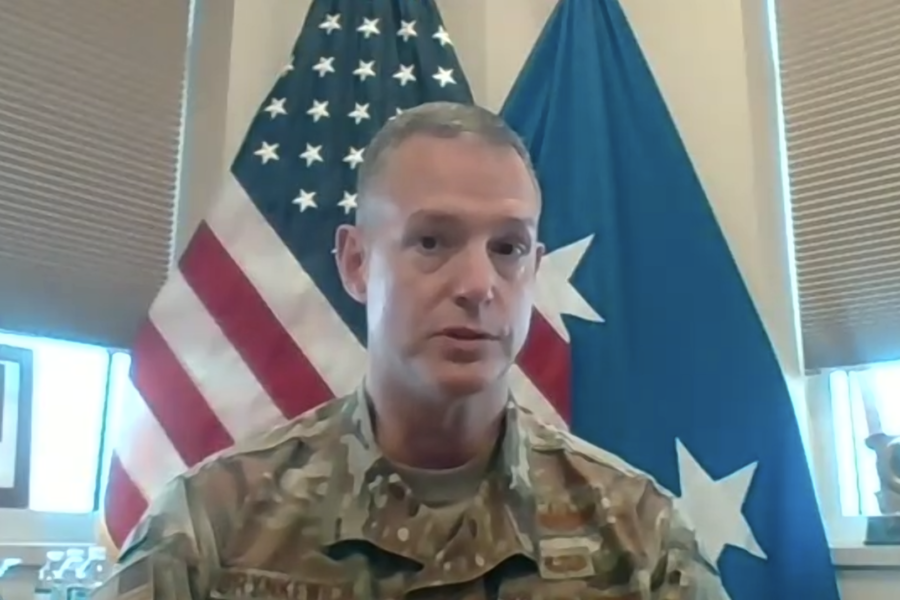The recently completed Global Posture Review directed further analysis to determine the right force mix in the U.S. Central Command area of operations, but one thing is certain, the command’s director of operations said Dec. 6: The U.S. footprint won’t look like it has in the past.
Through its Belt and Road Initiative, China intends to grow its overseas military capabilities, expanding into Central Asia, Europe, the Middle East, the Persian Gulf region, and Africa, with the overall objective of “adjusting the global order,” said Maj. Gen. Alexus G. Grynkewich, U.S. Central Command director of operations, during an AFA Air and Space Warfighters in Action virtual event.
“China cannot achieve their objectives without going through the U.S. CENTCOM AOR,” Grynkewich said. “So, as we look at what our posture is in the Middle East, we need to recognize China as an aspiring global power—they’re not just a regional problem—and think about what a sufficient force level is in CENTCOM. Again, it’s going to be nothing like it was in years past, with a couple of ground wars at their heights a decade ago or so. But it certainly is not zero.”
China also gets about 50 percent of its hydrocarbons, the main component in petroleum and natural gas, from the Central Asia region. “That means something,” Grynkewich added. “It means that the central region is important to China. And if it’s important to China, it probably ought to be important to us, as well.”
Grynkewich did not offer specifics of what the classified Global Posture Review revealed, but he did say that in the short term to expect a reduced force presence, something that is already coming to fruition with the withdrawal from Afghanistan. There will also be a shift to a more dynamic operating concept.
The drawdown in Afghanistan resulted in a downsizing of U.S. forces in the region. Grynkewich noted that the two fighter squadrons previously based in Afghanistan are no longer in the command and that the U.S. tankers and intelligence, surveillance, and reconnaissance assets that previously supported those operations have been repositioned.
In the future, he said, the U.S. is more likely to rotate forces into CENTCOM on an as-needed basis, depending on the situation on the ground. “In other words, rather than having a Carrier Strike Group in U.S. CENTCOM all the time, you’ll see a Carrier Strike Group come and go as the situation dictates,” he said.
Grynkewich said as the airpower and overall force posture changes, it’s “natural” to also re-evaluate the value of key operating locations such as Ali Al Salem, Kuwait; Al Dhafra Air Base, United Arab Emirates; al-Udeid Air Base, Qatar; and Prince Sultan Air Base, Saudi Arabia—all key launching pads for counterterrorism operations.
“It’s very meaningful to those nations that we have a presence there,” he said. “They view it as important to their own security that the Americans are there with them. And, so, it’s critical. That doesn’t mean that the installations are going to stay static. Certainly the number of Airmen at those locations, the number of Guardians, and others at those locations will change as our footprint changes.”
The 2020 ballistic missile attack on al-Asad Air Base, Iraq, also re-enforced the potential vulnerability of bases in the region to Iranian ballistic missiles and attacks by Iranian proxies.
“I think those nations are very aware of that,” Grynkewich said. “It’s not just a threat to our Airmen that are there, if you will. It’s a threat to the capital cities of many of those countries, and so they’re very keen to think about what it means to them … from a defensive perspective to have U.S. capabilities.”
At the same time, he noted, U.S. Central Command continues to think about the importance of building relationships with host nations, and operationally, what those host-nation agreements might mean for future contingency planning.
“We’re always going to be re-evaluating exactly what the footprint is, and do we have the bases where we want them to be,” he said. “I think given the importance that those bases have to the relationship, any decision to shutter a base or something like that would certainly be made at a higher level than U.S. Central Command, just because of the implications on the relationships that it would have.”
